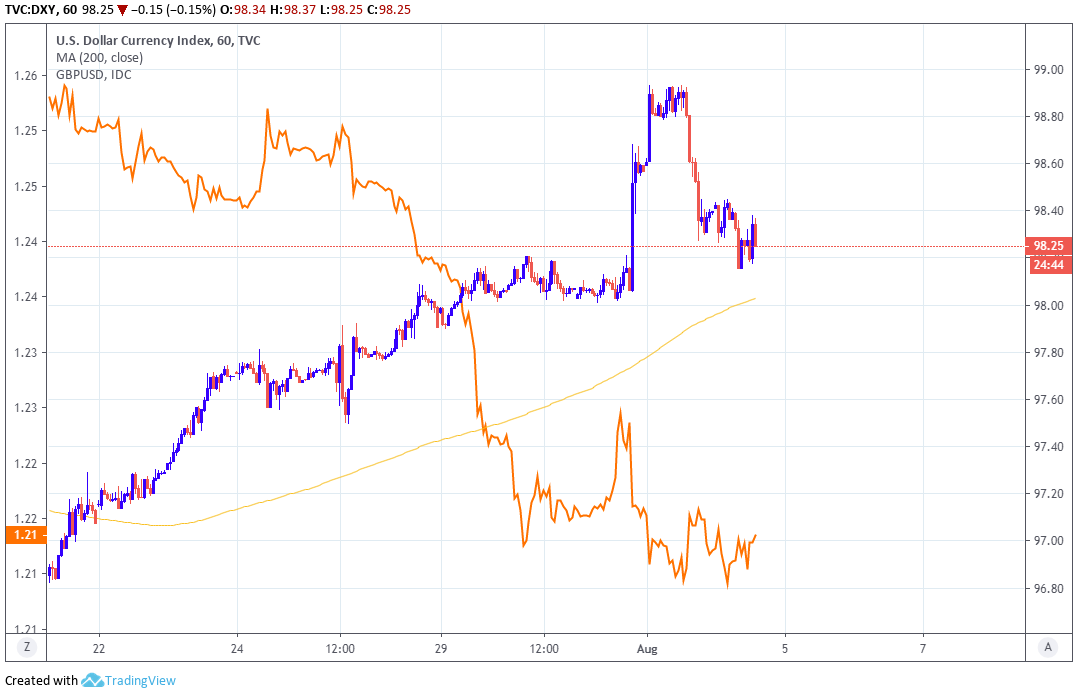The U.S. Dollar Steadies on July Nonfarm Payrolls Report but Tariff Man Looms Large
- Written by: James Skinner

Image © Adobe Images
- USD stabilises in wake of July nonfarm payrolls report.
- Payrolls seen at USD-supportive and Fed-inhibiting pace.
- But new China tariffs threaten U.S. and global economies.
- Seen auguring more Fed rate cuts and undermining USD.
The Dollar appeared to stabilise Friday as investors bid for the currency in the wake of a nonfarm payrolls report that revealed ongoing strength in the jobs market through July, which some say vindicates the Federal Reserve (Fed) for its decision to be cautious in cutting interest rates.
The U.S. economy created 164k new jobs in July, in line with the market consensus but below a downwardly-revised 193k from June. That kept the unemployment rate steady at 3.7% when investors were looking for a decline to 3.6% although the disappointment was made up for by faster wage growth. Pay packets were up 0.3% in July when the consensus was for only 0.2%, which lifted the annual rate of pay increases to 3.2% and continued a recent trend.
"The Fed cut rates without much evidence that the US economy was in serious trouble, and that's still the case after looking at July's payrolls figures," says Avery Shenfeld, chief economist at CIBC Capital Markets. "The data are consistent with our call for just one more Fed cut, given that the US actually needs to see growth no higher than 2% to avoid overheating the labor market."
The U.S. jobs market appeared to wobble back in May when it created just 75k new positions, stoking investor speculation the Fed would soon need to cut its interest rate, only for the subsequent June number to then initially be reported at 224k. The Federal Reserve did still cut its interest rate this Wednesday.

Above: Dollar Index shown at hourly intervals alongside the Pound-to-Dollar rate (orange line, left axis).
"This is still a labour market that is “strong” and “in a good place,” as Powell put it on Wednesday. The concern, of course, is that trade tensions will have a greater impact on the US economy in the coming months—a risk that is getting harder to dismiss. We expect the Fed will cut rates again in September," says Josh Nye, an economist at RBC Capital Markets.
Markets care about the labour market data because falling unemployment and improving job creation are thought to put upward pressure on wages. Pay growth leads to increased demand in an economy and upward pressure on inflation, with implications for interest rates and financial markets.
Friday's data comes after President Trump wrote in a Twitter post late Thursday that China's remaining $300 bn of exports to the U.S. will be subjected to a 10% tariff from September 01 after White House negotiators returned home "constructive talks" aimed at addressing the other side's "unfair" trading practices. That's in addition to a 25% tariff already covering another $250 bn of China's annual goods trade.
"The announcement by President Donald Trump of further tariffs on Chinese imports has rattled the markets, but we have long suspected that it was only a matter of time before the trade dispute escalated further. With those tariffs likely to have a more serious impact than previous measures, this reinforces our view that economic growth will slow sharply over the second half of this year, and is another reason to expect the Fed to cut interest rates by a further 50bp by early 2020," says Andrew Hunter at Capital Economics.
Above: Dollar Index shown at daily intervals. Annotated for recent events.
"Despite a cutting Fed, the USD continues to retain its yield advantage," says Mazen Issa, a strategist at TD Securities. "We think USD weakness off the back of lower yields (which it has been tracking more closely than equities) should be contained. This is also aided by the fact that when the world needs to seek refuge, the USD acts as the safe harbor....If this is Trump's thinly veiled attempt to weaken the USD, it's a swing a miss."
Trump's apparent strategy of using tariffs in order to pressure China during trade negotiations follows a market disappointment over the latest Federal Reserve interest rate guidance, with the bank saying it has not begun a cycle of rate cuts and hinting strongly that the 100 basis points of reductions to the Fed Funds rate that financial markets had come to expect is not a done deal.
The Fed did cut its interest rate for the first time since the aftermath of the financial crisis on Wednesday, taking the Federal Funds rate range down 25 basis points to between 2% and 2.25%, but two of the 17 voters on the Federal Open Market Committee (FOMC) opposed the move. The bank also announced an early end to the 'quantitative tightening' that's seen it drain Dollars from the financial system as it stops reinvesting proceeds of maturing bonds acquired through quantitative easing.
The Fed told markets it will "monitor the implications of incoming information for the economic outlook" while contemplating the "future path" of U.S. interest rates. That part about contemplating the future path of rates was seen by investors and analysts as a suggestion the Fed has not made up its mind on whether it'll need to be cut further in the months ahead.
"A weaker USD and lower USD funding costs are necessary conditions for global reflation. The problem is that the Fed has delivered arguably one of the most hawkish cuts in recent memory,and it seems that the bar for further cuts is higher than we previously thought – which should keep USD stronger for longer," says Hans Redeker, head of FX strategy at Morgan Stanley.
Above: Pound-to-Dollar rate shown at daily intervals.
"The Fed has just delivered the most bizarre rate cut in its history, in our view. Both we and markets were expecting it, but it was still unjustified. The US data has been solid, with unemployment at all-time lows, growth above potential, fiscal policy stance loose and inflation broadly at the target. Powell justified the cut based on trade tensions, increased uncertainty and weak global data," says Athanasios Vamvakidis at Bank of America. "We have been arguing for the last two months that the market was overpricing the Fed."
Bond and derivatives markets were pricing-in around 75 basis points of cuts for 2019 and another 25 basis points of cuts in 2020 before the Fed decision on Wednesday, but by Thursday the overnight-index-swap (OIS) market was beginning to lean toward only one more cut for this year. However, investors are now looking for even more 'easing' before year-end than they had been before the Fed left them empty-handed Wednesday night.
That suggests they see Trump's latest volley of tariffs as being likely to augur the additional 'easing' they've been after for months now.
On Friday morning the midpoint of the Fed Funds range implied in the OIS market was just 1.67%, which means investors are now close to having priced-in an additional two cuts for the 2019 year that would leave the Fed Funds range at 1.5%-to-1.75%. On Thursday morning, long before the tariffs were announced but after the Fed disappointment, the implied midpoint was 1.8%. This suggests hopes of a third cut were fading fast because the same midpoint had been 1.74% the previous day.
Changes in rates are normally only made in response to movements in inflation, which is sensitive to growth, but impact currencies because of the push and pull influence they have over capital flows. Those flows tend to move in the direction of the most advantageous or improving returns, with a threat of lower rates normally seeing investors driven out of and deterred away from a currency.
"The Fed minutes (August 21) and Jackson Hole (beginning August 22) offer the Fed the chance to correct market expectations, but while we wait for that, August will see a substantial increase in bill issuance (US$157 billion), draining liquidity from money markets even despite the early end to balance sheet normalization. These conditions are USD-positive and risk-negative," says Morgan Stanley's Redeker.
Time to move your money? Get 3-5% more currency than your bank would offer by using the services of foreign exchange specialists at RationalFX. A specialist broker can deliver you an exchange rate closer to the real market rate, thereby saving you substantial quantities of currency. Find out more here.
* Advertisement




